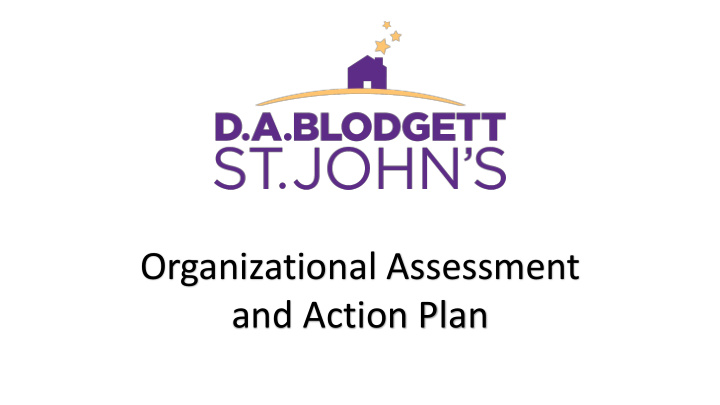



Organizational Assessment and Action Plan
The F he Fou oundation f for or O Organizational Asses essmen ent
St Strategi egic P c Plan
St Strategi egic P c Plan I Inputs
D.A. Blodgett – St. John’s ● Strategic Planning Process External and Internal Data Inputs External – Funders, Public, Donors, Potential Donors, Collaborators, Competitors KConnect Annual Report Kids County in Michigan Data Profile (Kent and contiguous counties) Local Needs Statements from DABSJ Grant Proposals WMPC Master Contract, CQI Plan, and Evaluation Plan Michigan Department of Health and Human Services Implementation, Sustainability and Exit Plan (ISEP) Stakeholder Focus Groups and Surveys • DABSJ Advisory Council Session Council on Accreditation External Survey
D.A. Blodgett – St. John’s ● Strategic Planning Process External and Internal Data Inputs Internal – Staff, Leadership, Board, Clients, Volunteers, Partners 2014-17 Strategic Plan (salient carryover goals) Human Resources • 90 Day Staff Satisfaction Survey • Annual Staff Satisfaction Survey • Staff Exit Survey • Merit Matrix Report for Wages and Benefits Performance and Quality Improvement Reports • Program Outcomes Reports • Risk Management Prevention Report Facilities Plan (including technology) Board Strategic Planning Session Annual Financial Audit (with industry benchmarks) 2016-19 Operating Funds Budget (with Risks and Rewards Analysis) 2016-20 Capital Expenditure Budget CEO Evaluation and Goals Strengths-Weaknesses-Opportunities-Threats (SWOT) Analysis Partners for a Racism-Free Community (PRFC) Assessment and Action Plan Secondary Traumatic Stress Survey Report
Both the First and Second Quarter CEO reports discussed Organizational Assessment as a primary objective in our new strategic plan: “Goal 1.7 - Initiate a review of organizational structure including leadership roles and responsibilities to increase staff capacity and implement recommendations.” Identified as a top priority for 2017. Critically important as it pertains to our primary goals of increasing the quality, capacity, and sustainability of our programs and agency. The leadership team concluded a four month process and meticulous analysis of every program's staffing pattern, hierarchy, funding sources, target population, demand for services, significant trends, caseload sizes, opportunities, and sustainability. Our intention was to create an organizational 'map' the agency will intentionally evolve into – and one that strengthens our competitiveness and impact in the community.
ORGANIZATIONAL ASSESSMENT: APPROACH Start with a blank slate and build the organization from the ground up, with nothing but our mission and vision, contracts, and accreditation and regulatory standards to guide us. Set individual agendas and departmental boundaries aside, leaving “but that’s how it’s always been” at the door. Acknowledge and integrate a core belief that administrative and infrastructure capacity must be more than just sufficient to get by day to day – it must be comprehensive and responsive to support not only the tremendous responsibility we have to deliver exceptional service, but also the inherent risk and liability we carry in doing so.
CURRENT LEADERSHIP STRUCTURE
MANAGEMENT AND GENERAL (M&G) National Median for Nonprofits: 12.6% National Mean for Nonprofits: 16.3% Michigan Mean for Like Nonprofits: 15.8% DABSJ: 7.6%
NEW LEADERSHIP STRUCTURE
POSITION TITLE: Chief Operations Officer POSITION SUMMARY Provides senior level leadership, management, and vision necessary to ensure the agency has effective operational systems, controls, and resources required for organizational strength and sustainable growth. Core areas of responsibility include Performance and Quality Improvement (PQI); Risk Prevention and Management (RPM); exceptional compliance with licensing, contractual, accreditation, and regulatory authorities; talent acquisition and retention; staff training and development; information systems and technology; data collection and reporting; and facilities. Champions and advances agency Diversity and Inclusion initiatives.
POSITION TITLE: Chief Programs Officer POSITION SUMMARY Leads the direct service divisions of the agency, and is responsible for program development, innovation, best practice, and client outcomes excellence in balance with productivity demands and financial sustainability. Serves as a central strategist, working closely with the senior management team to identify and articulate internal and external needs and opportunities in alignment with the organizational mission, vision, and master strategic plan. High-visibility position and requires strong internal and external communication skills with the highest level of direct service experience, clinical acumen, integrity, accountability, transparency, and professionalism.
POSITION TITLE: Manager of Quality and Risk POSITION SUMMARY Responsible for ongoing development and implementation of the agency’s Performance and Quality Improvement (PQI) and Risk Prevention and Management (RPM) plans. PQI Focus: tracking program and client outcomes, performance indicators and metrics, and other deliverables as determined by contracts, Council on Accreditation Standards, and the agency’s Strategic Plan. RPM Focus: strict oversight, monitoring, and mitigation of agency risks across all administrative and program areas.
Th The N New PQ PQI and R RPM PM Cycl cle of of Ex Exce cellence ce Chief Chief Operations Programs Officer Officer Directors Quality and Supervisors Staff Managers Risk Manager
Next St Step eps
August 21 - Presentation to supervisors and managers for feedback, Q&A. September 11 - Presentation to Executive Committee. September 17 - Presentation to full Board of Directors. September 18 - Post COO and CPO positions. September 29 - CEO completes vetting and selection process.
Ques estions ns?
Recommend
More recommend